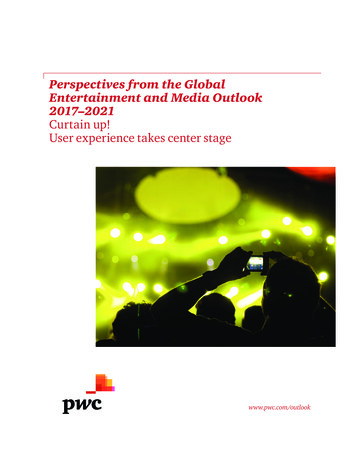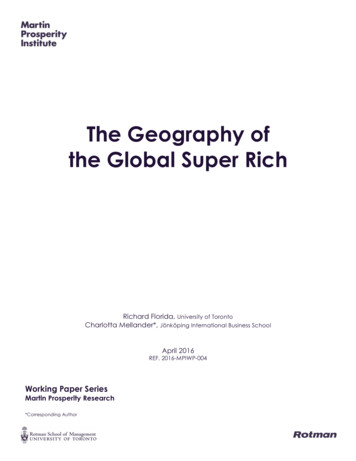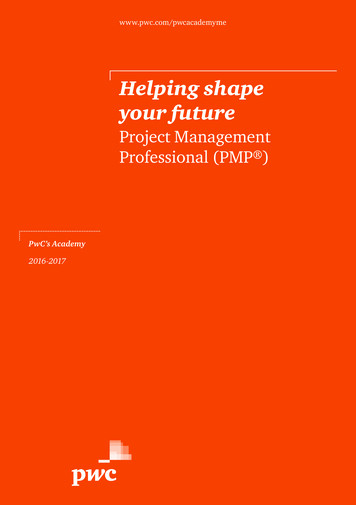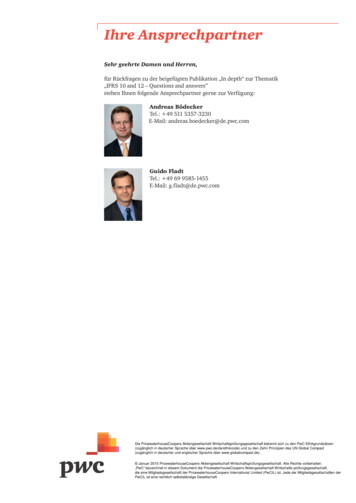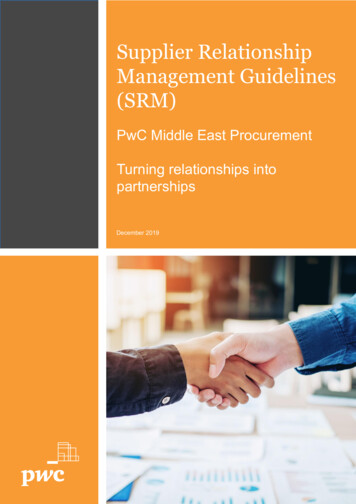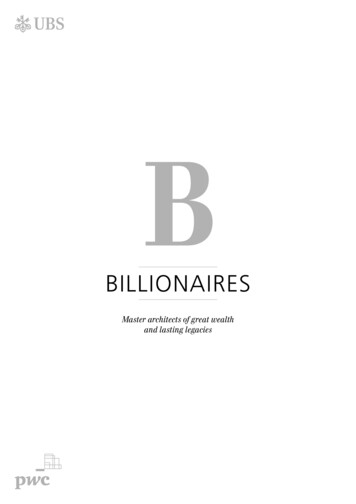
Transcription
BILLIONAIRESMaster architects of great wealthand lasting legacies
CONTENTS5INTRODUCTION:A PIONEERING REPORT6EXECUTIVE SUMMARY8GREAT WEALTH – THE BIG PICTURE,A CENTURY OF EXPERIENCE15PATTERNS OF GREAT WEALTH CREATION19STRATEGIC OPTIONS FORGREAT WEALTH PRESERVATION27EVOLVING PHILANTHROPY30OUTLOOK – THE WAY FORWARD3 UBS/PWC BILLIONAIRES 2015
4 UBS/PWC BILLIONAIRES 2015
INTRODUCTION:A PIONEERING REPORTWelcome to the UBS/PwC 2015 Billionaire Report, which sheds new light on the story ofgreat wealth – how it’s created, preserved and how it breeds philanthropy.The past 35 years have been a period of extraordinary wealth creation by billionaires. Only the ‘Gilded Age’ at thebeginning of the 20th Century bears any comparison. Then fortunes were created from industrial innovation, in sectorssuch as steel, cars and electricity. Now they are being made from the consumer industry, technology and financialinnovation in the US and Europe, as well as consumer products, globalization, industrialization and infrastructure boomsin Asia and other emerging markets.We have looked back over the latter half of what we call a second ‘Gilded Age’ and found that 917 self-made billionaireshave created fortunes of more than US 3.6 trillion in this period. Along the way, they have driven the development ofthe internet and its ecosystems, perhaps the greatest innovation of our time, led Asia’s consumer products revolution,and developed Asia’s factories, infrastructure and real estate. They have also set up some of the hedge and private equityfunds that have revolutionized finance.Our report is one of the most comprehensive studies of this historic era of wealth generation. We analyze data coveringmore than 1,300 billionaires, looking back 19 years. The data surveys the 14 largest billionaire markets, which account for75% of global billionaire wealth. Additionally, we have conducted face-to-face interviews with more than 30 billionaires.Notably, we believe this period of extraordinary wealth generation may soon decelerate. While this analysis is historical,our belief is that the conditions in which billionaires thrive are cyclical. The response to rising inequality, increasing taxesand asset price deflation may all play a part in slowing the current cycle. At the same time, scientific innovation in fieldssuch as biotechnology, artificial intelligence, robotics, nanotechnology and cyber security, as well as the growing needs ofan ageing population, suggest that some new opportunities for aspiring billionaires will emerge.From a demographic point of view, the current generation of billionaires is ageing. Two thirds of them are in the corridorof wealth transfer, with many of them still facing the decision of what their legacies will be. We expect a major upsurge inphilanthropy, perhaps even surpassing that at the end of the first ‘Gilded Age’.Josef StadlerGroup Managing DirectorUBS Wealth ManagementHead Global Ultra HighNet WorthJohn MathewsManaging DirectorUBS Wealth ManagementAmericas Ultra High Net WorthMichael SpellacyPartnerPwC USGlobal Wealth Leader5 UBS/PWC BILLIONAIRES 2015Dr. Marcel WidrigPartnerPwC SwitzerlandPrivate Wealth Leader
EXECUTIVESUMMARY// Second ‘Gilded Age’ – The world is in a second‘Gilded Age’, comparable to the first ‘Gilded Age’ atthe beginning of the 20th Century. The majority ofthe world’s billionaires have made their wealth in thepast 20 years, when they have created more thanUS 3.6 trillion. US entrepreneurs have created mostwealth, leading a wave of innovation in technology andfinance. Asia’s new industrialists, consumer producttycoons and real estate investors have also participated,seizing opportunity from rapid macro-economicgrowth, globalization and urbanization. Rising realestate and capital markets have played a strong role inthe creation of new billionaires.// Levelling off likely – Contrary to some observersof our time, we believe this second ‘Gilded Age’ isunlikely to go on forever but will level off. Just aseconomies grow in cycles, so the opportunities thatled to this most recent exceptional period of wealthgeneration are likely to come to an end. Tax, socialequality initiatives, asset price deflation and geopoliticaltensions – there are approximately 40 civil wars andarmed conflicts raging – will likely have significantconsequences for great wealth creation.// Youthful starts – Self-made billionaires tend to launchtheir first ventures at a young age, although few attainbillionaire status before their 40th birthdays. 23%launched their first venture before the age of 30, whilea total of 68% did so before reaching 40. Interestingly,almost half worked in a large company before makingtheir breakthrough. Against the current myth ofbillionaire dropouts, 82% of all self-made billionaireshave a college degree.// Personality traits – Distinct personality traits allowcreators of great wealth to thrive, according to ourresearch. Billionaires typically have three characteristicsin common: an appetite for clever risk taking, businessfocus and determination. But while some highly visibleentrepreneurs excel in risk taking and starting upbusinesses, they are often less good at running andscaling a business which explains why they often teamup with strong partners. Others are able to both buildand sell as they observe a niche that is not covered andfill it.// Sustainable legacies – As this generation of selfmade billionaires ages, they have to decide what theirlegacies will be. Almost two thirds of billionaires areover 60 years old and have to choose how to preservetheir achievements and to transfer their wealtheffectively either to future family generations, tophilanthropic causes or some combination of the two.Without a clear and sensible governance and strategy,wealth can swiftly dilute over generations, throughdeath, divorce and taxes. Planning and structuring forthe long term are critical, and some billionaires aresetting up sophisticated structures (i.e. family offices)with the characteristics of private equity to safeguardtheir legacies. Increasingly, large billionaire families areheld together through meticulously drafted chartersdealing with critical governance issues.// Great philanthropy – We expect an unprecedentedwave of philanthropy in its many forms – foundations,endowments, socially-focused investing, the artsand education. Following the first big wave of USphilanthropy at end of first ‘Gilded Age’ (Carnegie,Rockefeller), this can already be seen in the US with themost visible example being Bill Gates’ ‘Giving Pledge’,where more than 100 billionaires have pledged morethan 50% of their wealth to philanthropic causes.However, we also expect philanthropy to grow inother countries, where its particular form is and will beadapted to the regional and cultural context.6 UBS/PWC BILLIONAIRES 2015
US entrepreneurs have createdthe most wealth, leading a waveof innovation in technology andfinance. Further east, Asia’s newindustrialists, consumer producttycoons and real estate investorshave also participated.Self-made billionaires tend to launchtheir first ventures at a young age,although few attain billionairestatus before their 40th birthdays.Rising real estate and capitalmarkets have played a strong rolein the creation of new billionaires.More than 100 billionaires havepledged more than 50% of theirwealth to philanthropic causes.of all self-made billionaires have acollege degree.7 UBS/PWC BILLIONAIRES 2015
GREAT WEALTH –THE BIG PICTURE,A CENTURY OF EXPERIENCEWealth generation: a cyclical pattern“History does not repeat itself, but it often rhymes,”Mark Twain is reputed to have said.In the story of great wealth creation, this is certainlythe case. At the beginning of the 20th Century, a smallnumber of US and European entrepreneurs took advantageof new industrial technologies to drive forward some ofthat century’s greatest innovations. In the process theyamassed great fortunes. Almost one hundred years later,the cycle is happening again, only this time it’s innovationin technology and finance, the economic rise of emergingmarkets, and inflating asset prices which have fuelledextraordinary wealth generation.According to most historians the first ‘Gilded Age’ lastedfrom 1870-1910. In this period, a few businessmen builtthe organizations that industrialized innovations, bringingus for example the car, steel and electricity. Over the past35 years, US entrepreneurs have taken advantage of newtechnologies to create the internet and its ecosystem.They have leveraged new opportunities in finance tolaunch hedge and private equity funds. Globally (andin Europe especially), the consumer industry has been amajor driving force behind great wealth creation. Asia andother emerging market entrepreneurs have respondedto globalization by building mega-cities, powered andconnected by new infrastructures. Appreciation of assetprices over the last decades has driven billionaire wealthacross the globe, whether through real estate or assetssuch as art and intellectual property.The people pioneering such great economic changehave benefited most. In the past 19 years alone (19952014), 917 self-made billionaires have created in excessof US 3.6 trillion of wealth. In emerging markets, therewere relatively few billionaires before this period. Now thebillionaire entrepreneur is an established phenomenon andChina, for example, has created a significant share of theworld’s self-made female billionaires.We believe that, like economic growth, great wealthcreation has cycles. Wealth creation tends to move inS-curves, rather than growing linearly. At the end of thefirst ‘Gilded Age’, economic depression, higher taxes andthe emergence of large public companies suppressedthe opportunities for creating great wealth. The‘entrepreneurial age’ yielded to a ‘managerial economy’phase which lasted 50 years (1930-1980). In this time, afew big, established companies dominated economiesleaving little room for entrepreneurialism. Consequently,we believe that current growth in great wealth cannot beextrapolated out forever with any certainty. In our opinion,current extreme growth is likely to level off in the next10-20 years, although Asia’s economic momentum maysignal that the cycle lasts longer there than in the US.8 UBS/PWC BILLIONAIRES 2015
Great wealth historically happened in cycles and with diverging paths post-1980Income top 0.01 percentileFirst ‘Gilded Age’‘Managerial Economy’Second ‘Gilded Age’Share of top 0.01% in total ntries)19001920Entrepreneurial age19401960Managerial economy19802000Entrepreneurial age* Share of top 0.01% income excluding capital gains as data for capital gains incomplete, capital gains expected to amplify inequalitySource: Piketty (2014), World Top Income Database (2014), UBS and PwC analysis9 UBS/PWC BILLIONAIRES 20152014
10 UBS/PWC BILLIONAIRES 2015
11 UBS/PWC BILLIONAIRES 2015
Two developments that may hinder the growth of greatwealth are slowing economic growth in emerging markets(especially in the BRIC countries) and the significant share(approximately two thirds) of the current generation ofbillionaires that is in the corridor of wealth transfer (i.e. areover 60 and approaching the time when it is prudent toplan their legacies). As our data shows (see chapter three),once wealth gets handed over to the next generation ittends to fragment and dissipate rapidly.Beyond these factors, there are a number of others thatmay slow down the entrepreneurial era. Rising inequalityconcerns may spur punitive rises in wealth/inheritancetaxes (which are under discussion in countries such as theUS, Germany and Switzerland). Regulators in some regionsare looking into reining in monopolistic market structures(e.g. the EU’s investigations into technology firms), echoingrestrictions that helped to end the first ‘Gilded Age’ (e.g.US Sherman Anti-Trust Act).Centered mainly on the US and AsiaIn just a short 35 years, the second ‘Gilded Age’ has turnedthe world’s billionaire population upside down. Until 1980,the overwhelming majority of billionaires lived in the USand Europe. What’s more, in 1996 only approximately45% of US billionaires and 25% of European billionaireswere self-made. In the last decade, the US and Asia havebecome the main centers of great wealth creation, withEurope faring less well. Many billionaires have crystallizedtheir wealth by listing businesses they have createdon stock exchanges, and then sold down their sharesperiodically to gain portfolio diversity.Of the more than 1,300 billionaires in-scope globally,with wealth of US 5.4 trillion (up by US 4.7 trillionfrom US 0.7 trillion in 1995), 66% were self-madebillionaires, compared with just 43% at the beginning ofour study period in 1995. Most of these new billionairesare based in the US, where 47% of the in-scope selfmade billionaire wealth was resident in 2014. But Asia’sentrepreneurs, too, have participated in this entrepreneurialexplosion. Asia’s billionaires account for 36% of self-madebillionaire wealth, pushing Europe into third place as alocation for great wealth, with just 17% of the self-madebillionaire population.USMacro events have shaped the way that wealth is ACIndustrialization(1st ‘Gilded Age’)DynasticTechnology/finance revolution(2nd ‘Gilded Age’)Big firmTransfer to familyIndustrializationglobalization(1st ‘Gilded Age’)Source: PwC analysis12 UBS/PWC BILLIONAIRES 2015
While US entrepreneurs have driven a global revolutionin finance and technology, Asia’s tycoons have been keyparticipants in the region’s accelerated industrial andconsumer revolutions, with the building of mega-cities andincrease in real estate prices. Europe hasn’t participated inthis second ‘Gilded Age’ to such a degree. Where it hasdone so, entrepreneurs have made their fortunes fromconsumer goods and industrial products.Inherited wealth makes way for entrepreneursThe present era of great wealth creation has seen aregeneration of billionaire wealth. In 2000, the numberof self-made billionaires overtook the number of multigenerational billionaires for the first time since the first‘Gilded Age’. And, in 2014, entrepreneur billionaires madeup 66% of the total billionaire population. This structuralchange of wealth breeds innovation and economic growth.The current class of billionaires has created growth,opportunity and wealth for broader society through thefirms that they have founded.There has been massive wealth creation over the past 19years, but there have also been a large number who nolonger qualify. Only 40% of the billionaire class of 1995remain in this elite wealth bracket. Both the high numberof drop outs and the burgeoning population of newbillionaires mean that only 9% of 2014’s billionaires werein this elite wealth bracket 19 years earlier.In the first part of our 1995-2014 study period, billionairewealth far outperformed the financial markets. But sincethe dot.com bubble burst in the early 2000s it has becomefar more correlated with financial markets.Billionaire wealth growth in the last 19 years is strongly driven by entrepreneurial wealth creationBillionaire wealth of in-scope markets*Global, USD 9519982001200453%66%35%34%20132014n Self-made n Multi-generational* In-scope markets consist of 14 richest billionaire markets and represent 75% of global billionaire wealthSource: PwC Billionaire Database, UBS and PwC analysis13 UBS/PWC BILLIONAIRES 2015
14 UBS/PWC BILLIONAIRES 2015
PATTERNS OFGREAT WEALTH CREATIONRegional variations in sources of wealthThe common perception of a contemporary self-madebillionaire is a technology wizard, driving a fast-growingengine of digital innovation. In fact, this is only partlyaccurate. Our research database shows that sources ofgreat wealth tend to vary depending on geography.Even in the US, technology is not the dominant source ofnew fortunes. Instead, the financial services sector hasspawned the largest number of US self-made billionairesduring our study period (30.0%), while technologyhas produced the second highest number (27.3%). Buttechnology billionaires are almost twice as rich, averagingUS 7.8 billion in wealth, far exceeding financiers’ averageof US 4.5 billion.In Europe, the consumer industry dominates both in termsof number of self-made billionaires (49.5%) and averagewealth (US 5.7 billion). Entrepreneurs have made theirfortunes from founding the region’s large retail houses.Technology entrepreneurs rank a distant second, makingup a far smaller proportion of the population (9.7%), withlower average wealth of US 3.8 billion.Asia’s self-made billionaires have also chiefly made theirmoney in the consumer sector (19.8% of billionaires arefrom the sector, with average wealth of US 3.2 billion).The region’s real estate boom has produced the secondhighest number of billionaires (12.9% with average wealthof US 2.7 billion).Billionaire personality traitsBillionaires are different. Their fortunes aren’t the resultof good luck or social background. Instead, self-madebillionaires have distinct personality characteristicsthat allow them to approach the challenge of creatingnew value differently from most corporate managersand leaders.In order to identify these characteristics, we reviewedan array of academic research, survey analysis and casestudies, as well as conducting face-to-face interviews withbillionaires. Our research and analysis consistently identifiedthree personality traits as essential for entrepreneurialsuccess. These are: smart risk taking, obsessive businessfocus and dogged determination.Smart risk takingSelf-made billionaires tend to have a very optimisticattitude towards risk, focus on risks they understand andfind smart ways to reduce them. What’s more, their keeninstinct for risk and opportunity often allows them to exitat the peak, transferring risk to others. The clever risktaking splits into three angles:1. Their risk profile is skewed towards focusing on theupside and being realistic on the downside (andnot being scared by it). They’re afraid to lose by notcapturing an opportunity, tending not to worry aboutthe downside of a new venture failing but insteadbeing concerned about missing out on the upside: “Ifyou want to be successful in a big, big way you have togo where the biggest risks are, because that is wherethe biggest opportunities are as well,” one billionairetold us. Another billionaire, from the industrial productsindustry, attributed the success of his ventures toextreme confidence: “With many investments I am soconfident that I automatically buy double or triple thefactory capacity I originally estimated, because I justdeeply believe in the tremendous upside and don’twant to be later limited in what I can achieve,” heexplained. It is not that self-made billionaires ignorethe downside risk, rather they have an accurate senseto identify value at the right level of risk versus at a toohigh risk.15 UBS/PWC BILLIONAIRES 2015
One very interesting observation during the interviews was that ‘focus’is critical to how self-made billionaires work. The one critical resource that evenbillionaires cannot buy is time.2. They look for asymmetrical opportunities where theydo have an advantage (like proprietary insights, accessto financing/liquidity or assets that in combinationwith the opportunity will create synergies). In thesesituations the risks for anybody without theseadvantages will appear high and they are likely to walkaway. Also they are keenly aware that there may besituations where they do not have these advantages.One billionaire focusing on principal investments toldus: “When I sit at the negotiation table I always askmyself who is the fool at the table. If I do not see one Iwill most likely walk away because the chances are highthat it is me.”3. They have very strong ability to recover from failure.On the one hand they rarely take ‘bet the house’ risks,but rather always keep enough resources to be ableto recover. On the other hand when the original ideafails they have the ability to ‘pivot’, i.e. they constantlyadjust the initial idea until they succeed. A self-madebillionaire from the retail industry told us: “Our currentbusiness model is the result of a series of failures andthe lessons we learned from them. If we would havestuck to the original business model we would bebankrupt by now.”Obsessive business focusSelf-made billionaires are constantly scanning the worldfor untapped opportunity. Curiosity is a core skill of mostself-made billionaires we met. This curiosity is constantlydriving them to look for unmet customer needs that createa significant business opportunity. In so doing, they veryoften have the advantage of insight based on in-depthknowledge of the industries in which they compete.After they have identified an opportunity they switch toan extremely focused modus operandi in execution thatsome observers could call ‘tunnel vision’. One intervieweecompared this to a fighter pilot who focuses on thehorizon and totally ignores things at the edge of his sight.“This would only distract me and likely would lead to acrash.” Another aspect of business focus is the tendencyto quantify everything. A good example is a billionairewe met in a London restaurant. In the middle of theconversation, he looked around and said: “What a greatplace. Do you think it makes money? Should I buy it?”He did a back of the envelope estimate of its profitabilityand concluded: “This is not going to last more than threeyears unless it is someone’s hobby.” This leads into anotheraspect of business focus. Self-made billionaires try to avoidemotions diluting the economics of a deal, or at least veryconsciously make a decision that they are prepared to paya price that otherwise may not be justified: “I was offereda company I always admired. When we discussed our offerstrategy I realized that I was emotionally attached to thatfirm and prepared to pay a significant premium that myteam did not see justified. I had to ask myself whether Iwant to make a business decision or want to fulfill a dreamI always had.”One very interesting observation during the interviews wasthat ‘focus’ is critical to how self-made billionaires work.The one critical resource that even billionaires cannot buyis time. This is why access to them is so highly restrictedand their schedule is so tightly scripted. On the upside, ifthey decide to give you some of their time they are fullydedicated. None of the meetings we had was disrupted byan assistant, there were no calls and none of them lookedat their mobile devices to check messages. When they arewith you they focus 100% on you.16 UBS/PWC BILLIONAIRES 2015
Dogged determinationBillionaires are highly resilient. Undeterred by failures androadblocks, they have a tremendous work ethic. Theyconfront and overcome obstacles, persevering in theface of adversity. In our discussions with billionaires, wefound that several start-ups of moderate success oftenpreceded the venture that led to the creation of greatwealth. In many cases, self-made billionaires do not viewrisk or failure in the same way as the general population.They often view risk from the perspective of not beingpositioned to capitalize on a business opportunity. As forfailure, one billionaire explained that the realization of asignificant business loss was the most important eventin his career. The loss focused his efforts and taught himnot to shrink from very difficult decisions. Our interviewsshowed that self-made billionaires often tend to be serialentrepreneurs who learn from their mistakes and doggedlywork towards great wealth creation. On occasion, theirtactics are aggressive; sometimes close to the boundariesof the law. Most interviewees we asked viewed a lifethreatening (for their company) crisis as an opportunity.One described a corporate crisis as an event “where youhave to make hard cuts and weed out the inefficienciescreated by growth and grab the opportunity created by thecrisis. In the last down market I bought one of my fiercestcompetitors who got wrong-footed by the crisis at fire saleprices, which turned out to be one of the best investmentsI have ever made.”Starting youngSelf-made billionaires start to make their breakthroughsyoung, although they do not tend to hit the billion-dollarmark until well after their 40th birthdays. More than a fifth(23%) launched their first venture before the age of 30,while over two thirds (68%) launched their first venturebefore reaching 40.Billionaires tend to have had the benefits of experience andeducation. Almost half of self-made billionaires worked ina large company before making their breakthrough, while82% have a college degree.Showing just how recently Asia has made its economicbreakthrough, the region’s new tycoons differ fromthose in other regions. 25% of them grew up in poverty,compared with just 8% in the US and 6% in Europe.They’re also younger than their peers in other parts of theworld. Asian self-made billionaires have an average ageof 57, making them almost ten years younger than theircounterparts in the US and Europe.17 UBS/PWC BILLIONAIRES 2015
18 UBS/PWC BILLIONAIRES 2015
STRATEGIC OPTIONS FORGREAT WEALTH PRESERVATIONGenerational transfer: the big challengeMost billionaires are in what we call the ‘corridor of wealthtransfer’, when they have to make the crucial decisionthat will define their legacy. Almost two thirds of them areover 60 years old, have more than one child and are at thepoint in their lives of having to choose what to do withtheir wealth. This choice is important, as fortuneswill quickly dilute without a sensible preservation strategyand governance.Some 57% of self-made billionaires and 67% of multigenerational billionaires are in this stage of life. Forentrepreneurs who have focused their lives on creatingwealth, this critical legacy issue has all too often been leftopen. They’re faced with the ‘who, what, when and how’legacy question as they look to make a transfer to the nextgeneration, the extended community and other intereststhat matter to them.Transfer to next generation is THE key challenge for all billionaires in the quest to preserve their lifetimeachievementBillionaire journeyCorridor of wealth transferTotal wealth Decision regarding wealthpreservation strategy andgovernance cannot be avoided(and if ignored mostly will haveled to a fast decline of greatwealth) and are key factorsof sustainability of lifetimeachievement1st GenerationEntrepreneurial billionaire2nd Generation onwardMulti-generational billionaireSource: PwC analysis19 UBS/PWC BILLIONAIRES 2015 Two basic options (maintainoriginal business vs. cash-out)are available plus the decision onrole of philanthropy
As clear wealth erosion is inevitable, wealth preservation cannot be taken as grantedBillionaire generation distribution*In-scope markets-47%5.75.34.83.53.3G1G2G3G467% G533%Average wealth n Number of billionaires* Charts show number of individuals, not families according to Forbes; founder of original business defined as 1st generation; G5 includes up to G11Source: PwC Billionaire Database, UBS and PwC analysis‘Generational algebra’ illustrates the dynamic of wealthdilution. The power of compound wealth fragmentationmeans that if each member of a family has three children,by the second generation there are nine family membersand by the fifth there are 243. Correspondingly, a sumof US 1 billion dilutes to US 333 million for each childwhen it’s passed on to the second generation. By the fifthgeneration, each child inherits US 12 million.This calculation shows the importance of strategic planningand long-term structuring for billionaires to protect theirlifetime achievements and preserve their values into thefuture. The decision of how to preserve wealth can notbe avoided. In the instances it has been ignored, thisindecision has mostly led to a fast decline in wealth.‘Generational Algebra’ shows dynamic of wealth dilutionNr.membersSource: PwC analysisAvg wealth(US million)Avg dividend(US million)1st generation31,00025.02nd generation933313.33rd generation271112.34th generation81370.95th generation243120.320 UBS/PWC BILLIONAIRES 2015
One sixth-generation patriarch summed up the secretsauce that made his family business sustainable:“Ultimately it comes down to three factors that need to bein place and working: 1. Financial dividends; there are nowmore than 20 families that depend in some way or theother on the annual payout. In years that we had to skipor reduce the payout, this can become difficult.2. Even more important is the emotional dividend. Weneed to keep every new member emotionally attached tothe firm from the day they are conceived. 3. There mustbe an exit gate that has clear rules and conditions underwhich somebody can leave the family business when heor she want to without destroying the legacy.”Keep the firm or cash out?When billionaires plan for their legacies, they have tochoose between keeping the businesses they have created,cashing out or some hybrid combination of these twooptions. One of the billionaires who sold his firm summedup this highly emotional point quite rationally. “One daywhen I looked up I had to realize that unfortunately I amnot going to be around forever. Nobody in the family wasin the slightest way interested or for that matter capable.What was the point of sticking with the firm? I decidedselling was a much easier option for my family, althoughit has been super-tough for me to see my legacy beingsucked into a multinational and six years on no traceis left.” Increasingly, billionaires also look into makingphilanthropy part of their legacy, particularly supportingareas such as education, healthcare and the arts.When billionaires plan for their legacies,they have to choose between
9 UBS/PWC BILLIONAIRES 2015 Great wealth historically happened in cycles and with diverging paths post-1980 1900 Share of top 0.01% in total income* Fi
